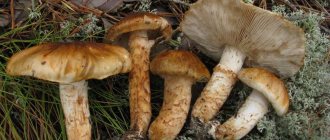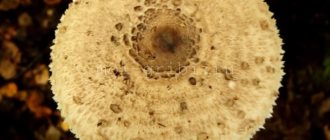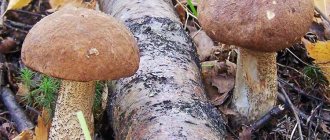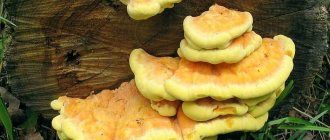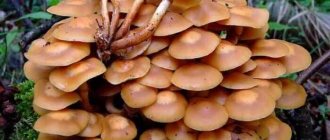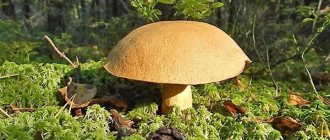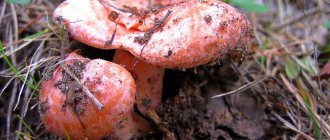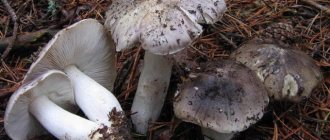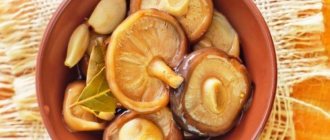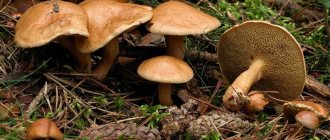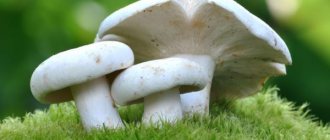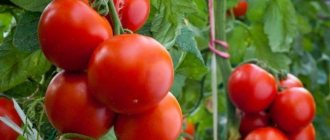The Krasnodar region has always been famous for its rich mushroom pantries, allowing for a harvest of edible and conventional mushrooms. So 2021 was no exception to the rule. From the beginning of spring, local residents began collecting forest gifts, both for food and for winter supplies. And if our readers still doubt the beginning of a quiet hunt, it’s time to compete with your mushroom hunting comrades by going on a search a few days after precipitation. Spring, summer, autumn and even winter are excellent times for searching, provided that the germinating subspecies is selected and the air temperature is not lower than 0.
In order to collect full baskets of mushrooms and leave the forest with a smile on their faces, local residents are advised to study the information left on forums and social networks before going for prey. Reviews will allow you to understand whether there are mushrooms in the forest today and how large a harvest you can collect by going into the forest, focusing on the mushroom map.
Kuban annually allows you to collect noble, edible and conventional mushrooms, suitable not only for frying and preparing first courses, but also all kinds of pickles and marinades for the winter, whose storage allows the use of a pantry, refrigerator or cellar, depending on the recipe. In 2021, the following mushrooms are in demand: porcini and porcini mushrooms, saffron milk caps and boletus mushrooms, champignons, honey mushrooms and boletuses, boletus and boletus mushrooms, moss mushrooms and semi-white mushrooms.
Mushroom places of the Krasnodar Territory and Adygea
The Krasnodar region is known for its warm and mild climate.
The “silent hunting” season in the region begins very early – in April. And its end falls in the last weeks of November. A large number of different mushrooms grow in Kuban. But not everyone knows where to collect them. In fact, everything is simple: you just need to use a map of mushroom places, because each species has its own ecological niche.
- For porcini mushrooms in the Krasnodar region, experienced mushroom pickers recommend going to the Saratov, Kaluga, and Smolensk villages. You should look for such fruits under hornbeams, birches and fir trees.
- Honey mushrooms grow in large quantities in Arkhyz and Goryachy Klyuch, in places of old tree fellings.
- Fans of milk mushrooms are recommended to visit the forests of the Kurgan, Otradnensky and Tikhoretsky districts.
And if you want to collect a generous harvest of boletus and boletus, then the forests of Sochi, Tuapse and Gelendzhik are best suited for this.
Silent hunt
The natural conditions in Kuban are such that absolutely everything grows here - from wheat to berries. Mushrooms were no exception. This is explained by the fact that Kuban’s location covers several climatic zones at once.
Different parts of the Kuban relief are distinguished by their diversity. Deciduous forests here can be abruptly replaced by coniferous ones, black soil is replaced by clay and sandy soils, which turn into rocky mountains. There is even a saying that if you stick a simple stick into the soil of Kuban, it will easily sprout. And this is actually practically true. The unique climate and fertile lands enable a huge variety of plants to develop in the rich soils of the Kuban.
But along with edible mushrooms, inedible ones also grow well. Therefore, harvesting must be taken seriously. During the mushroom season in the Krasnodar Territory, you can harvest without going into the forest. Here they can even grow in a personal plot under apricots or other fruit trees.
When going on a quiet hunt, you need to take a sharp knife, a wicker basket and a stick with you in order to conveniently move apart the foliage. It is not advisable to use plastic bags, buckets and backpacks to collect nature's gifts. In them, the crop can be damaged, and the mushrooms do not breathe there at all, which can adversely affect the taste of the product.
There is only one rule when hunting quietly. It says that if you are in doubt about mushrooms, you should not touch them. Also, when collecting, you need to know that they grow in families, that is, myceliums. And if one of them is found, his relatives are hiding nearby. They should be cut off with a sharp knife along with the stem. There is one more point you need to pay attention to. Often completely inedible mushrooms have a pleasant smell. Therefore, the mushroom picker’s rule applies here again - skip an unfamiliar species.
What mushrooms grow in October, at the beginning and end of the month
Description of mushrooms listed in the Red Book of the region
Kuban is a region where not only edible fruits grow, which can be collected without fear or restrictions. Here you can also find specimens listed in the Red Book of the Russian Federation. This:
- Summer truffle. Quite a rare and therefore valuable variety of mushrooms. It has a pleasant nutty taste and exquisite aroma.
- The float is crumbling. A rather rare species of fly agaric, which forms mycorrhiza exclusively with alder. It has miniature sizes (its cap rarely grows more than 3 cm in diameter). The flesh is thin-fleshed, and its color is pale ocher-beige or grayish.
- Cobweb is bluish or bluish-blue. Refers to edible mushroom species. But since it is an extremely rare crop, it is prohibited to collect it in the forests of the Kuban, as well as in other regions of Russia. The fruit got its name for its unusually beautiful appearance and bluish-lilac color.
Poisonous specimen
One of the dangerous mushroom representatives is the pig. Until some time, it was considered conditionally poisonous and was used in cooking. We consumed pork after a long preparation. It included 72 hours of soaking in water, then heat treatment in the form of boiling for one hour.
Types of edible and poisonous mushrooms in Belarus
Today, pig mushroom is officially recognized as a poisonous mushroom. It contains a hazardous toxin that destroys red blood cells and causes acute kidney failure. Its use can be fatal.
Therefore, when going to the forests of Kuban, you need to familiarize yourself with the appearance of potentially dangerous mushrooms.
Edible species
Now, like many years ago, the forests of the Krasnodar region abound with representatives of the mushroom kingdom. Most of the mushrooms growing in this area are edible and are well known to experienced connoisseurs of quiet hunting.
Thanks to the soil and climatic characteristics of the region, mushroom picking can be carried out as early as May, and the fruiting period continues until the onset of noticeable autumn cooling.
| Species name | Latin name | Description of the cap | Characteristics of the leg | Features of the pulp |
| Porcini | Boletus edulis Fr. | Hemispherical or convex shape, changes with aging to flat or cushion-shaped; Brown | Tuberous in shape, thickened at the base, solid, with a dry and matte surface, with a mesh pattern | Fleshy, dense, does not change when cut, with a fresh taste and pleasant smell |
| Grabovik | Leccinum griseum Sing. | Dry, slightly wrinkled, golden yellow or brownish | Straight or curved, thickened below, scaly-fibrous type | Thick and fleshy, fibrous, whitish-gray, darkens when cut |
| Yellow hedgehog | Hydnum repandum Fr. | Thick, convex, uneven, yellowish or pink-yellow in color, with wavy edges | Cylindrical, narrowed towards the base, pinkish in color | Same color as the flesh of the cap |
| Oiler grainy | Suillus granulatus | Mucous, hemispherical or cushion-shaped, yellow-red or brownish in color | Straight or slightly curved, cylindrical | Fleshy, yellowish-white in color, without a pronounced taste |
| Ordinary stitch | Gyromitra esculenta | Folded, irregularly shaped, brownish or brown in color | Bloated, uneven, folded-furrowed type | Thin, waxy, brittle, with a damp smell |
Oyster mushroom
Category 4 mushroom. The taste often depends on the culinary abilities of the cook, but their combination with meat and vegetable dishes has long become a classic.
Thanks to its unpretentious cultivation and abundant fruiting throughout the warm summer and autumn, it is easily cultivated at home.
When eaten regularly, oyster mushrooms help reduce the level of so-called “bad” cholesterol in human blood, normalize blood pressure and remove radionuclides. The pulp of these mushrooms contains calcium, iodine and iron compounds and other micro and macroelements, vitamins B, C, E, D2, PP. The ability to lower cholesterol levels is due to the presence in the pulp of the mushroom of a special compound - lovastatin, which biochemists call a natural inhibitor of cholesterol synthesis.
For mass production, we chose varieties that naturally grow on oak, willow, alder and the bark of weak, diseased deciduous trees.
- Oyster. The hat is curled downwards, the diameter reaches 5-25 cm. The color scheme is creamy-beige, the smell is subtle mushroom. In the natural environment it grows by the end of May, bears fruit until September, but under favorable conditions - until frost.
- Horn-shaped. A distinctive feature is the cap, curved upward when ripe, fan-shaped or tongue-shaped. The color is uneven, various shades of beige lighten at the edges.
- Oak. The shades of gray characteristic of the cap of this species depend on the wood, humidity and location of growth. The shape is lamellar, semicircular, the edges are wavy or jagged. The size rarely exceeds 15 cm, the surface of young specimens is covered with a white-gray coating, which is simply cleaned off.
Grainy boletus
The name comes from the specific milky-white drops that appear on the inner whitish-yellow surface and stem in wet weather. Their size is 1-2 mm, drying and becoming dense, brownish-brown.
In people with poor digestion and gastrointestinal diseases, they can cause nausea, vomiting, and diarrhea, so the first tasting should be done carefully, without overusing the product.
Description:
- the pulp of a young oiler is soft, with a nutty and fruity aroma, overripe fibers become coarser and are excessively saturated with moisture;
- the circumference of a smooth cap without a cover is up to 10-12 cm, the color of the cut remains unchanged;
- The skin is easily peeled off, but during rains it becomes covered with sticky mucus.
The fruiting period is short - from early June to July. Collection places are near coniferous trees, the edges of young plantings, sparse forests with sandy, loose calcareous soil. Granular boletus usually grows in groups.
It is recommended to peel the skin before cooking; it turns black after heat treatment.
Green moss mushrooms
They grow in single individuals on the edges of coniferous forests, sometimes deciduous. They choose well-lit areas and occasionally find themselves among bushes, anthills, and old stumps. They are considered healthy and tasty; the visible above-ground part is suitable for consumption.
Main characteristics:
- there are olive-brown, gray, yellow or greenish;
- legs length 10-12 cm, circumference up to 15-17 cm;
- Only the area of pressure on the cap turns blue;
- unripe pulp smells like dried fruit, the structure is dense, old pulp becomes more porous and loose.
Before cooking, you need to remove the skin; only young specimens can be eaten raw - if the “age” is unknown, be sure to boil for 10-15 minutes.
Graboviki
In appearance, the fruiting body of the mushroom is similar to the common boletus. The second (Russian name) is gray obabok. They are collected from early July to November. The maximum size of the spherical caps is 20 cm, the color varies from light walnut to dark brown.
The surface is soft, velvety, with irregularities. The hard fibrous stems are rarely used and do not darken when cut - this is how they can be distinguished from the inedible bitterling. On the contrary, the loose flesh, when broken, rapidly changes color from pink to inky purple.
The club-shaped leg is densely covered with light scales, darkening when ripe. At home, mushrooms are grown from April to October near deciduous trees.
Hornbeams grow well on heavy peat with high acidity; they require frequent watering to speed up the growth of mycelium; you can add 10 g of sugar per 10 liters of water.
Porcini
When starting to consider edible mushrooms in the Krasnodar region, of course, this is where you should start. Its cap is 8-25 cm in diameter, 2-6 cm thick, convex, hemispherical, sometimes flat and cushion-shaped, brown, dark brown, yellowish-brownish, light brown. The edge is solid, straight, thick, even. The surface is thin felt, smooth, sometimes dry, wrinkled, matte. In this case, the skin is not separated from the pulp.
The pulp is 1.3-4 cm thick, dense, fleshy, white when aging, more loose. The smell is pleasant, the taste is fresh. The tubes are 0.7-2 cm long, white. The porcini mushroom in the Krasnodar region has round, small, white pores that turn yellow over time. The lower part of the cap also turns yellow and becomes yellowish-greenish in old age.
The stalk is about 10 cm long, tuberously thickened towards the base, periodically almost cylindrical, slightly curved or straight, dry, solid, matte, light brown or whitish with a reticulate white pattern in the upper region of the stalk.
The porcini mushroom in the Krasnodar region is widespread (in the vicinity of the villages of Saratov, Smolensk, Kaluga, Stavropol, Goryachiy Klyuch), in hornbeam-oak, oak, fir-beech, pine forests, in bushes, in clearings, on sandy loam, clay soil.
The fox is real
When telling what mushrooms grow in the Krasnodar region, I would like to pay special attention to chanterelles. And this is primarily due to their appearance. The cap is 3-9 cm in diameter, up to 1.3 cm thick, convex, depressed in the middle, periodically funnel-shaped. The edge is bent down, wavy, solid, thin. The mushroom is yellow-egg-colored. The surface is dry, smooth, matte, bare, the pulp does not separate from the skin.
Fresh taste, pleasant mushroom smell. It is almost never affected by larvae. Hymenophore in the form of branched veins running down the mushroom stalk. The veins that replace the plates are narrow, thick in places, in the form of folds, very sparse, and are not separated from the pulp.
The leg is curved or straight, thinner in the lower part, passes upward into a cap, one-color, solid, eccentric or central, dry, smooth, matte, bare.
So where are mushrooms of this species collected in the Krasnodar region? Everywhere! Mountain and foothill belts are suitable for this (the area of the villages of Smolenskaya, Kaluzhskaya, Kamyshanova Polyana, Goryachiy Klyuch, between Lake Kardyvach and Krasnaya Polyana, in the area of Arkhyz, Psebay, not far from the village of Zelenchukskaya), in hornbeam-oak, mixed and coniferous forests ( Caucasian fir, aspen, beech, hazel, maple, hawthorn), on all kinds of soil, mainly with a cover of moss.
Amethyst or violet lacquer
The appearance of the violet (lilac) lacquer is so different from the familiar image of the edible mushroom of the Krasnodar region that not every lover of “silent hunting” will dare to put it in their basket. The small purple cap, up to 30 millimeters in diameter, has thin watery pulp of the same color and a rather pleasant delicate taste with a mushroom smell.
What mushrooms grow in a pine forest
Mycologists classify varnish as the fourth category of edible mushrooms in the Krasnodar region and recommend eating only the caps. It is worth noting that a roast made from purple mushrooms looks quite extravagant, even exotic.
Real honey fungus
You have already learned what mushrooms grow in the Krasnodar region. Now it’s worth considering the honey mushroom. Its cap is 5-10 cm, hemispherical, prostrate, flat-convex, dirty brown, gray-yellowish, darker towards the middle. The edge is bent down, then smooth, straight, thin, solid. The surface is absolutely dry, wet only in wet weather, covered with thin dark brown, brown scales.
Thin, unbreakable, fleshy, white flesh. Sourish-astringent taste, pleasant smell. The plates are short descending, frequent, white, then brownish-yellow, often with a coating of white spores, solid edge.
The leg is almost always curved. Cylindrical, central, slightly thickened at the bottom (occasionally growing singly, in a bunch), solid, the same color as the cap, slightly paler at the top. Furrowed above the ring, elastic and fibrous below. The blanket is in the shape of a whitish membranous ring.
Now we’ll find out where mushrooms are picked in the Krasnodar region. These are mountain and foothill belts (near the villages of Smolenskaya, Kaluzhskaya, Krepostnaya, Ilsky village, Psebay region, Kamyshanova Polyana, Arkhyz, Laba river), in clearings, in forests, at the base of trunks, on stumps, on the roots and living trunks of various breeds
White truffle (Polish, Trinity)
No matter how unexpected it may sound for fans of French cuisine, the Polish, or white, truffle can also be found in the Krasnodar Territory.
Its appearance and taste characteristics are somewhat different from its French counterpart, which makes the Krasnodar truffle less valuable in culinary terms. The body of the fungus is irregularly lumpy and resembles a potato tuber. Inside it has grayish-white pulp with a pronounced mushroom smell with notes of hazelnut. The cut pattern resembles marble. Collecting truffles requires serious practical skills, since the body of the mushroom is securely covered with a layer of pine needles or fallen leaves. Landmarks that indicate its presence can be hillocks of earth without grass cover or a strong specific smell. Favorite soils are clay or sandy, with a high moisture content. The collection season begins in the last third of summer and ends in mid-autumn.
In cooking, truffles are highly prized for their unique meat-like flavor. They are eaten both fresh and dried. Truffle sauces are rightly considered to be masterpieces of haute cuisine.
However, in some countries (including Europe) this unusual mushroom is classified as inedible and even poisonous, and in Spain the trade in truffles is prosecuted by law.
Yellow hedgehog
But you can find not only the mushrooms listed above in the Krasnodar region. There is also a yellow hedgehog. Its cap is 5-12 cm in diameter, convex, thick, mostly uneven, pink-yellowish or yellowish. The edge is most often wavy, irregular, and thick. The skin does not come off at all. The pulp is fleshy, thick (corky in old age), white. The smell and taste are mushroom, pleasant. The hymenophore consists of spines. The spines are very brittle, thin, pinkish.
The leg is usually curved, narrowed towards the base, cylindrical, less often central, more often eccentric, solid, creamy or whitish. The flesh is the same color as the flesh of the caps. It grows in the mountain and foothill zones (the area of the villages of Krepostnaya, Kaluzhskaya, Kamyshanovaya Polyana, Goryachiy Klyuch, between Lake Kardyvach and the Krasnaya Polyana village of Zelenchukskaya, between and Psebay). Mushrooms can be found in coniferous (pine, fir), deciduous and mixed forests.
Common boletus
Let's continue to look at mushrooms in the Krasnodar region. The common boletus has a cap 5-15 cm in diameter, 3-4 cm thick, cushion-shaped, hemispherical, almost black-brown or brownish-white. The edge is solid, straight, thick. The surface is slightly wrinkled or smooth, matte, dry.
The pulp does not separate from the skin. It is fleshy, up to 2.5 cm thick, white, dense. The upper layers turn blue at the break, the main mass darkens or turns slightly pink. Without any special smell or taste. The tubes go to the edge of the cap. Their pores are round, small, creamy white or white, and sometimes turn brown as they age. The leg is spindle-shaped at a young age, thickened at the bottom, then almost cylindrical, white, solid, covered with dark brown, grayish scales. The pulp is fibrous, dense, strong. The leg turns blue when broken at the periphery.
Mushroom picking takes place in the mountain and foothill zones (the area of the villages of Smolenskaya, Kaluga, Engelmanova Polyana, Kamyshanova Polyana and Goryachy Klyuch), in deciduous and mixed forests of aspen, beech, fir, birch, pear, apple, hornbeam, hazel (hazel), on different soils.
Entoloma garden
Entoloma tastes like oyster mushrooms
It grows in mixed, broad-leaved forests; often the mycelium grows in gardens under apricots and plums. Collection season is mid-spring and early summer.
Experienced mushroom pickers recommend not cutting the crops grown in the garden plot for the first 3 years, giving the mycelium the opportunity to grow sufficiently.
Characteristics of pink plate:
- the body is grayish-brown, the smell is mild, mealy;
- the taste is mostly neutral, there is a similarity to oyster mushroom;
- considered conditionally edible, requires mandatory boiling for 15-20 minutes;
- the surface is silky, glossy, later covered with dark brown scales;
- the plates are sparse, with uneven edges of different widths;
- the curved, cylindrical leg often twists.
An unripe specimen is similar to some poisonous mushrooms: crushed entoloma, tin mushroom, spring mushroom. The first symptoms of intoxication appear 30 minutes after consumption, the condition requires emergency hospitalization.
Summer mushrooms of the Krasnodar region
Summer is a period of real forest riot of mushrooms in Kuban. It would be quite difficult to list all the species that can decorate a mushroom picker’s basket in the middle of the summer season, because it would result in a whole scientific work. Therefore, I will limit myself to the most common and massively growing species that form the basis of commercial mushroom collection.
Common boletus
Common boletus
begins to bear fruit here at the end of May, its season ends in late autumn. A typical boletus mushroom, tubular, the cap is hemispherical or cushion-shaped, the stem is scaly, smooth or widening at the base, with flesh bluish along the edge. A pleasant feature of these mushrooms in the Krasnodar region is that watery specimens characteristic of the middle zone are almost never found here. In Kuban, almost all boletus mushrooms are dense and elastic. True, the worms also eat them very actively and it can be difficult to find an intact specimen.
Boletus
Aspen boletus
Around the same time, aspen boletuses, red and yellow-brown varieties, appear in forests and forests. These are dense tubular mushrooms with a stem covered in black scales, a dense convex cap of yellow, brownish, red or brick colors. Easily distinguished by the intensely blue flesh when broken.
In the Kuban, these mushrooms grow especially abundantly on the border of the forest-steppe and subtropical zones, in particular in Krasnaya Polyana. Large populations were also seen in the Belorechensk area. In the Krasnodar Territory you can find truly gigantic specimens of boletus mushrooms; the personal record of the author of this article is a mushroom that fell slightly short of 3.5 kilograms. And without a single worm, as is typical for boletus.
Camelina Pine, here more often called “delicious camelina”
A small lamellar mushroom of red, reddish, sometimes with a greenish tint, with a convex or funnel-shaped cap. In the Krasnodar Territory, this delicious mushroom has taken a liking to the foothills and slopes of low mountains, where it is found very abundantly. Very large harvests are collected by local residents in the area of the village with the unpronounceable name Arkhz, and large populations also grow near the village of Chibiy.
Poisonous varieties
The number of varieties of inedible mushrooms reaches hundreds. Some types of poisonous mushrooms are very similar in appearance and smell to edible ones. Such specimens are especially dangerous for children’s bodies. Therefore, it is necessary to ensure that children do not taste any mushrooms in the forest.
Death cap
It is one of the characteristic representatives of the fly agaric genus. It has a fairly recognizable appearance. The flat cap is painted in light grayish-greenish tones. The size of the cap does not exceed 150 millimeters. The leg is cylindrical, white, 150 - 160 millimeters high. The pulp is white, practically odorless.
Inexperienced mushroom pickers often confuse young toadstools with champignons, greenfinches or russula. Knowing the characteristic features of this dangerous mushroom will help you avoid mistakes:
- The presence of a bedspread (volva) in the form of a light-colored thickening located under the cap.
- The presence of soft white plates on the back side of the cap.
- Formation of a thickening (sac) at the base of the mushroom stalk.
What edible mushrooms are collected in the Volgograd region
Another sign indicating that the mushroom picker is dealing with a toadstool is a translucent ring located on the stem. By the way, this element is characteristic of several types of poisonous mushrooms, which makes it possible to confidently distinguish them from their edible counterparts.
Boletus (legal boletus)
As the name logically suggests, this poisonous mushroom belongs to the noble boletus family. Its main differences are: a large smooth cap of a convex shape and orange (pink) color, a wide swollen leg with a characteristic reddish mesh and a general squatness of the body.
Satanic mushroom
Outwardly, it strongly resembles boletus mushrooms, the surface of the cap is white, grayish, the leg is yellow-red, with a bright red mesh pattern. When broken or cut, the flesh quickly turns red, turns blue along the edges, then the flesh returns to its previous white color. The mushroom is not very poisonous, but can cause quite severe stomach upset. On the territory of the Krasnodar Territory it is found quite often and abundantly, which makes it dangerous. Grows everywhere in deciduous forests.
Satanic mushroomExpert opinionGennady Sergeevich RylovA great expert in mycology and an avid mushroom picker. Knows everything about mushrooms, their types and places of growth. It is important to note here that this list is far from complete. Almost all types of fly agarics, a huge number of toadstools and hallucinogenic mushrooms grow in Kuban. Therefore, more complete information should be emphasized from the mushroom encyclopedia, this is very important!
Fly agaric red
Amanita muscaria
The most famous, perhaps, is a poisonous mushroom with a bright red cap covered with characteristic white flakes, with a white ringed stalk and an ovoid depression at the base. Fortunately, it is rare in the Kuban region, mainly in mountainous areas, and grows from July to September.
Inedible and poisonous mushrooms of Kuban
Walking through the forest in search of tasty forest gifts, a novice mushroom picker may come across fruits that are unsuitable for consumption due to an unpleasant taste and smell, or because they contain poisons and toxins. Fruits to stay away from in the forest are:
- Death cap. This is one of the most dangerous poisonous mushrooms in Russia. It is found everywhere - in gardens, plantings, forests, parks, meadows. The fruit can be recognized by its greenish color, the presence of a vulva and a ring on the stem.
- Entoloma is poisonous. A large mushroom, the diameter of the cap can reach 16 cm. The cap is yellow-white or grayish in color, and the flesh has a pronounced floury smell.
- Red fly agaric. The inedible mushroom is familiar to many mushroom pickers - both experienced and beginners. It has a red outstretched cap with white flakes on the surface. The leg is thin, high, ringed. Fortunately, this specimen is rare in the Kuban, mainly in mountainous areas.
In the forests of Kuban you can stumble upon false doubles of mushrooms suitable for consumption. They are not always dangerous to health, but they have an unpleasant odor and disgusting taste. Therefore, the main advice of experienced mushroom pickers is to refuse to collect unfamiliar fruits, even if they look very attractive in appearance.
Little tricks of the Kuban mushroom picker
Do you explore the forests of your regions in search of mushrooms? Of course! I’m going to
The geographical features and climate of Kuban leave their mark on such a seemingly common task as picking mushrooms.
I will list a few tips based on local specifics:
- When going mushroom hunting, choose shoes that will be comfortable for walking not only on the forest floor, but also on rocks. Many types of mushrooms will lure you quite high into the mountains, and moving there in the usual rubber boots with smooth soles will be extremely uncomfortable.
- For the same reason, it is best to use buckets rather than baskets as containers for mushrooms. It is very easy for a person unaccustomed to moving in the mountains to fall here. We can say that you will certainly fall on your first trip. An ordinary basket will most likely not withstand such a test.
- Kuban has a fairly humid climate with high summer temperatures. Therefore, containers for mushrooms must be well ventilated. It is best to make a sufficient number of holes in plastic buckets with a drill for free access of air.
For “mushroom tourism” the Belorechensky, Apsheronsky districts and the surroundings of Goryachiy Klyuch are best suited. These are the richest mushroom crops and fairly easily traversed areas.
Have the mushrooms gone, what they write on the forum?
Nothing has been written about 2021 yet, since the mushroom season here begins in early spring. First, mushroom pickers go for the most frost-resistant types of mushrooms, which can bear fruit even at low temperatures; later in the mushroom meadows you will see more competitors, which means that closer to summer the number of germinating edible trophies increases.
Mushrooms of Adygea 2021 forum is an excellent place for those beginners who need the help of experienced mushroom pickers, for whom it is important to know the main coordinates of hot spots, other useful tips and landmarks.
Distribution area and mushroom places
In areas with a humid subtropical climate, in particular in the Krasnodar Territory, edible and very tasty birch bark mushrooms grow on fallen trees. It is important to note that among the tree species of mushrooms there are practically no poisonous ones, which greatly simplifies the collection. Edible goats and flywheels most often grow in conifers.
Oak, hornbeam-oak, pine, fir-beech, beech-fir forests and clearings are rich in porcini mushroom , which can grow either singly or in small groups.
, hornbeam has become widespread which prefers clayey soils and grows both singly and in fairly large groups. Harvesting a large harvest of yellow hedgehog will not be difficult in deciduous and mixed forests, as well as coniferous forests, regardless of the type of soil.
Granular oiler mostly grows in foothill and mountain zones and is most often found in pine and mixed forests with fairly moist soil. There you can also find oak milk mushrooms, which grow in very large groups. Almost everywhere on wood, often rotten, grows a delicious and very popular garlic mushroom.
Collection time and features of use of mushrooms
In terms of the diversity of mushroom species, the Krasnodar Territory can be compared with the Far East, but the peculiarities of soil and climatic conditions allow the collection of fruiting bodies for quite a long time.
Thousands of lovers of quiet hunting travel through suburban forest belts on weekends. Depending on the species characteristics, mushroom picking can begin as early as May , and the last harvest can be collected before the onset of significant autumn cooling. Of course, main collection dates are approximate and may vary slightly depending on weather conditions each year.
| Species name | Category | Terms of main collection | Use of fruiting bodies |
| White mushrooms | First | Between May and September | Universal |
| Grabovik | Second | Between July and September | Cooking, frying, stewing, drying |
| Yellow hedgehog | Fourth | Between July and November | Boiling, stewing and frying |
| Oiler grainy | Second | Between April and November | Boiling, frying, stewing, drying, pickling |
| The fox is real | First | Between May and November | Boiling, frying, stewing, marinating |
| Oak milk mushroom | Second | Between June and October | Pickling |
| Green moss | Third | Between May and October | Boiling, frying, stewing, drying, pickling |
| Garlic | Fourth | Between July and September | Cooking, frying, stewing, drying |
According to experienced mushroom pickers, the most favorable mushroom places in the Krasnodar Territory are oak forests near the Ubinka River, as well as the Crimean, Seversky, Apsheronsky and Tuapse regions, Goryachiy Klyuch and the outskirts of the city of Gelendzhik. A significant number of milk mushrooms, aspen mushrooms, boletuses, white mushrooms, moss mushrooms, trumpet mushrooms and white mushrooms grow near Barabinsk. Here, regardless of skill, there is always the opportunity to collect a rich harvest of tasty and healthy mushrooms.
Sources
- https://sveklon.ru/griby-krasnodara
- https://DachaDecor.ru/gribi/sedobnie-i-nesedobnie-gribi-krasnodarskogo-kraya
- https://pro100ogorod.ru/griby/krasnodarskogo-kraya-i-adygei.html
- https://FB.ru/article/275618/gribyi-v-krasnodarskom-krae-syedobnyie-gribyi-nazvaniya-opisaniya-gde-i-kogda-sobirat
- https://grib.guru/mesta/vse-o-gribah-v-krasnodarskom-krae
- https://GriboWiki.ru/tips/griby-krasnodarskogo-kraya.html
